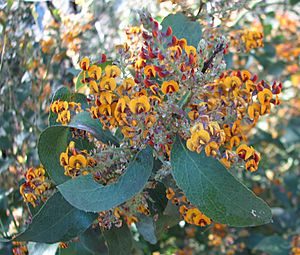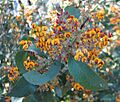Hop bitter-pea facts for kids
Quick facts for kids Hop bitter-pea |
|
|---|---|
 |
|
| Daviesia latifolia Mount Buffalo National Park, Victoria |
|
| Scientific classification | |
| Kingdom: | |
| (unranked): | |
| (unranked): | |
| (unranked): | |
| Order: | |
| Family: | |
| Genus: | |
| Species: |
D. latifolia
|
| Binomial name | |
| Daviesia latifolia |
|
Daviesia latifolia, often called hop bitter-pea, is a special shrub found in Australia. It belongs to the Fabaceae family, which is known for its pea-like flowers. This plant is only found in Australia and some nearby islands.
The famous botanist Robert Brown first described this plant in 1811. You can find Daviesia latifolia growing across the eastern parts of Australia.
Contents
What's in a Name?
The name Daviesia comes from a botanist named Hugh Davies. He was a plant expert who lived a long time ago. The second part, latifolia, is from Latin words. "Latus" means broad, and "folium" means leaf. So, latifolia means "broad-leaved," which describes its wide "leaves."
It's called "hop bitter-pea" for a few reasons. "Bitter" because its "leaves" taste bitter when crushed. "Pea" because its flowers look like tiny peas. The "hop" part is because early European settlers used it as a substitute for hops in brewing.
What Does It Look Like?
Daviesia latifolia is usually an open or woody shrub. It can grow between 1 to 3 meters tall, and sometimes even up to 5 meters! It spreads out about 1 to 1.5 meters wide.
Leaves and Flowers
This plant doesn't have true leaves. Instead, it has special flattened stems called phyllodes. These phyllodes do the same job as leaves. They are tough and leathery, about 2.5 to 8 cm long and 2 to 3 cm wide. You can see clear veins on them, and they often have a wavy edge. Young phyllodes look similar to the older ones, just a bit wider.
Daviesia latifolia blooms from spring to summer. Its flowers are usually plentiful and shaped like peas. They are orange-yellow with dark reddish-brown or maroon colors in the center. These flowers grow in clusters along the stems.
Fruit and Seeds
After flowering, the plant produces a triangular-shaped fruit. This fruit turns brown when it's ripe. Inside, it holds seeds that are surrounded by a special fleshy covering called an aril. The plant usually produces fruit from November to February.
You can tell D. latifolia apart from other Daviesia species by its broad "leaves" with their clear net-like veins and its unique triangular pods.
Where Does It Grow?
This plant is native to the eastern parts of Australia. You can find it from the cooler temperate zone in Tasmania all the way up to the warmer subtropical areas of northern New South Wales, Victoria, and Queensland. It can even grow at high altitudes, up to 1800 meters!
Daviesia latifolia likes to grow in places where eucalyptus trees are common. This includes dry sclerophyll forests, woodlands, or mallee areas.
Preferred Conditions
This shrub is often a main plant in the undergrowth of dry sclerophyll forests, especially where fires happen regularly. It prefers partly shady spots but can also handle full sun. It can even tolerate a little bit of frost.
Daviesia latifolia can grow in most light to medium soils, as long as the ground drains well. Scientists think that Daviesia plants are important for the environment because they might help add nitrogen to the soil. This process is called nitrogen fixation and helps other plants grow.
Uses of the Hop Bitter-Pea
The phyllodes (the "leaves") and stems of Daviesia latifolia can be used to make a fawn-colored dye. To make the dye stick, people use a substance called alum as a mordant.
Traditional and Modern Uses
The phyllodes also have some medicinal properties. Early European settlers supposedly used the "leaves" to help get rid of intestinal worms. They also made a drink from the phyllodes to treat certain internal cysts and as a general health tonic. The plant was also used as a substitute for hops to flavor beer.
Even though it's not widely grown, Daviesia latifolia can be a beautiful addition to a garden. Its interesting "leaves" and fragrant flowers make it visually appealing. It can also help make the soil healthier because its roots can fix nitrogen. This means it helps put important nutrients back into the soil.
This plant also helps local wildlife. It provides pollen and nectar, which are food sources for native birds and many different insects.
Images for kids
-
Daviesia latifolia in Mount Buffalo National Park, Victoria



